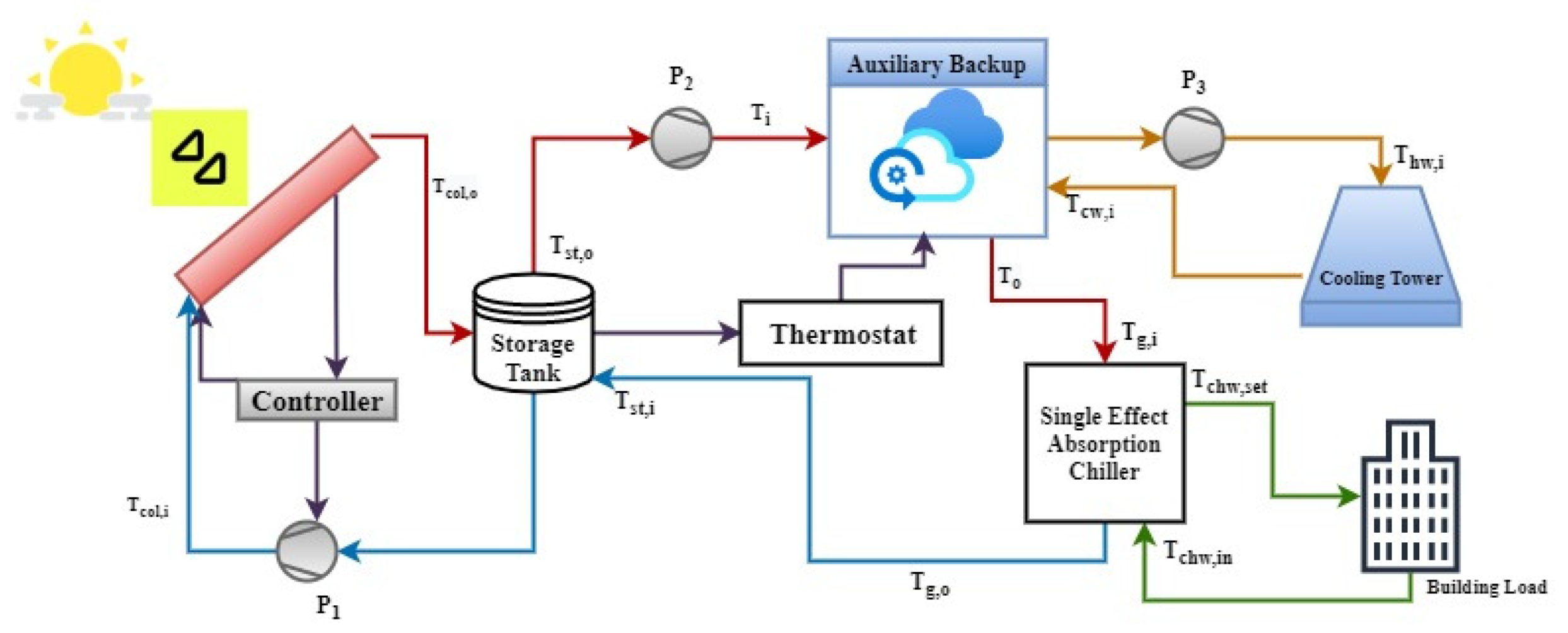Model Based Transient Analysis of a Solar Assisted Absorption System for Multi-Climate Zones with Dynamic Building Load †
Abstract
:1. Introduction
2. Description of System’s Configuration and Modeling in TRNSYS
3. Results and Discussion
4. Conclusions
- It was found that to achieve fsav of at least 50%, the required evacuated tube solar collector areas are 600 m2 for Cairo, Lahore and Abu Dhabi. Similarly, 50% primary energy is saved for flat plate collector areas of 1600 m2 for Cairo, Lahore and Abu Dhabi.
- The collector efficiency increases by increasing storage volume, but this increase is less sensitive for higher values of storage volume. At a higher volume, the exposed surface area of the storage tank is greater, causing thermal losses.
Funding
Institutional Review Board Statement
Informed Consent Statement
Data Availability Statement
Conflicts of Interest
References
- Ahmad, T.; Zhang, D. A critical review of comparative global historical energy consumption and future demand: The story told so far. Energy Rep. 2020, 6, 1973–1991. [Google Scholar] [CrossRef]
- Ghenai, C.; Rejeb, O.; Bettayeb, M. Performance of Solar Lithium Bromide Water Absorption Air-Conditioning System for a Conference Hall in Hot Desert Climates. In Proceedings of the 2019 8th International Conference on Modeling Simulation and Applied Optimization, Manama, Bahrain, 15–17 April 2019; pp. 1–5. [Google Scholar]
- Rahman, S.; Said, Z.; Issa, S. ScienceDirect Performance evaluation and life cycle analysis of new solar thermal absorption air conditioning system. Energy Rep. 2020, 6, 673–679. [Google Scholar] [CrossRef]
- Siddiqui, M.A. Exergy analysis of single to triple effect lithium bromide-water vapour absorption cycles and optimization of the operating parameters. Energy Convers. Manag. 2019, 180, 1225–1246. [Google Scholar]
- Shoaib, M.; Khan, A.; Waheed, A.; Talha, T.; Wajahat, M.; Sarfraz, F. Configuration based modeling and performance analysis of single effect solar absorption cooling system in TRNSYS. Energy Convers. Manag. 2018, 157, 351–363. [Google Scholar]




| Sr. No | Name of City | Köppen Classification Group | Climate Description |
|---|---|---|---|
| 1 | Cairo (Egypt) | Bwh | Arid Hot desert |
| 2 | Lahore (Pakistan) | Bsh | Semi-Arid–Steppe |
| 3 | Abu Dhabi | Bwh | Arid Hot desert |
Publisher’s Note: MDPI stays neutral with regard to jurisdictional claims in published maps and institutional affiliations. |
© 2022 by the authors. Licensee MDPI, Basel, Switzerland. This article is an open access article distributed under the terms and conditions of the Creative Commons Attribution (CC BY) license (https://creativecommons.org/licenses/by/4.0/).
Share and Cite
Sadiq, A.; Ali, M. Model Based Transient Analysis of a Solar Assisted Absorption System for Multi-Climate Zones with Dynamic Building Load. Eng. Proc. 2021, 12, 100. https://doi.org/10.3390/engproc2021012100
Sadiq A, Ali M. Model Based Transient Analysis of a Solar Assisted Absorption System for Multi-Climate Zones with Dynamic Building Load. Engineering Proceedings. 2021; 12(1):100. https://doi.org/10.3390/engproc2021012100
Chicago/Turabian StyleSadiq, Atiya, and Muzaffar Ali. 2021. "Model Based Transient Analysis of a Solar Assisted Absorption System for Multi-Climate Zones with Dynamic Building Load" Engineering Proceedings 12, no. 1: 100. https://doi.org/10.3390/engproc2021012100
APA StyleSadiq, A., & Ali, M. (2021). Model Based Transient Analysis of a Solar Assisted Absorption System for Multi-Climate Zones with Dynamic Building Load. Engineering Proceedings, 12(1), 100. https://doi.org/10.3390/engproc2021012100







